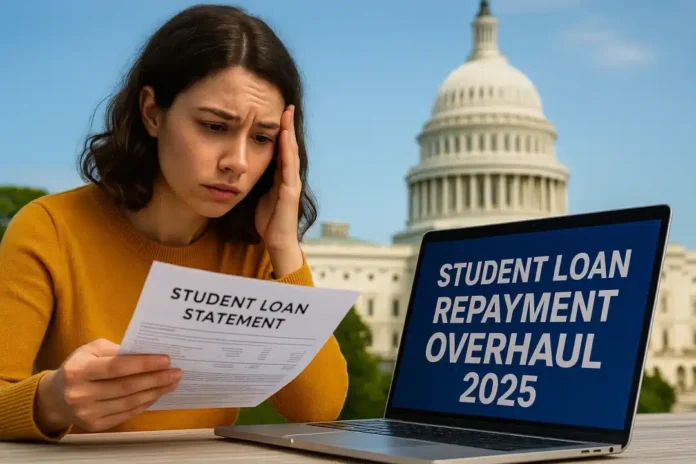The U.S. Senate has passed major reforms to federal student loan programs as part of a massive reconciliation bill, marking a pivotal moment for millions of borrowers nationwide. The Senate narrowly passed the bill on Tuesday, with the massive package now heading back to the House for a final vote before potentially reaching President Trump’s desk.
This landmark student loans senate bill represents the most significant overhaul of federal student lending in years, fundamentally changing how borrowers will repay their debt and access federal education funding. The legislation transforms repayment options, borrowing limits, and deferment policies in ways that will impact both current and future students.
Major Changes in the Student Loans Senate Bill
The reconciliation package introduces sweeping modifications to the federal student loan landscape. Under the Senate Republican proposal, there would be just two repayment plan choices for those who borrow federal student loans after July 1, 2026, dramatically reducing the current dozen options available to borrowers.
Key Changes Summary:
- Elimination of most income-driven repayment plans
- New borrowing limits for graduate and professional programs
- Modified deferment and forbearance options
- Changes to loan rehabilitation policies
- Revised Pell Grant eligibility requirements
The student loans senate bill creates a simplified but potentially more expensive repayment structure for millions of Americans. A typical student loan borrower with a college degree could pay an extra $2,929 per year if the Senate GOP proposal of RAP is enacted, compared with the Biden administration’s now-blocked SAVE plan, according to recent analysis.
Graduate Student Borrowing Limits Face Dramatic Cuts
Graduate and professional students face particularly significant changes under the new legislation. Under the Senate’s proposal, graduate borrowers would have a lifetime borrowing limit of $100,000, and up to $200,000 for students in professional programs, like medical school.
These caps represent a substantial reduction from current unlimited borrowing options for graduate students. The changes specifically target:
- Graduate Programs: $100,000 lifetime limit
- Professional Programs: $150,000-$200,000 limits
- Parent PLUS Loans: $65,000 cap per undergraduate student
- Undergraduate Loans: Increased from $31,000 to $50,000
Financial aid experts warn these restrictions could limit access to advanced degrees, particularly in fields requiring extensive education like medicine, law, and doctoral programs.
Repayment Plan Overhaul Creates New Challenges
The student loans senate bill fundamentally restructures how borrowers repay their federal education debt. Current borrowers enjoy approximately twelve different repayment options, but the new legislation streamlines this to just two primary choices for future loans.
Borrowers struggling to repay their loans will no longer be able to defer due to unemployment or economic hardship, but it would also give borrowers the ability to rehabilitate defaulted loans twice instead of the current one time that is allowed.
This change eliminates critical safety nets that millions of borrowers currently rely on during economic difficulties. However, the legislation does provide some relief by expanding loan rehabilitation opportunities for those who have defaulted.
Impact on Current Borrowers and Future Students
The timing of these changes creates a two-tiered system affecting different groups of borrowers differently. Students taking loans after July 1, 2026, will face the new restrictions, while current borrowers may retain some existing benefits.
Higher education advocates express concern about the potential consequences. Financial experts predict the reduced flexibility could trigger increased default rates, particularly among borrowers facing economic hardship who previously had access to unemployment or economic hardship deferments.
House Vote Determines Final Fate
Before reaching President Trump’s desk, it will have to clear one last vote in the House, where some Republicans are signaling opposition. The bill’s future remains uncertain as it faces this final legislative hurdle.
The House version of the reconciliation package contained different provisions, and reconciliation between the two chambers’ approaches will determine the final shape of student loan reforms. Some Republican representatives have expressed reservations about certain aspects of the Senate-passed version.
Long-term Implications for Higher Education
The student loans senate bill represents a philosophical shift in federal education policy, moving away from income-driven repayment models toward more traditional fixed-payment structures. This change could affect college enrollment patterns, particularly in graduate programs with high borrowing costs.
Universities and colleges are closely monitoring developments, as reduced graduate borrowing capacity could impact enrollment in advanced degree programs. Professional schools may need to adjust their financial aid strategies to accommodate new federal lending restrictions.
The legislation also includes provisions affecting institutional accountability, potentially changing how colleges and universities participate in federal student aid programs. These changes could reshape the higher education landscape for years to come.
What Borrowers Should Do Now
Current borrowers should continue making payments under existing repayment plans while monitoring legislative developments. The final bill must pass the House before becoming law, and implementation timelines suggest most changes won’t take effect until 2026.
Prospective students considering graduate or professional programs should carefully evaluate their financing options, as the new borrowing limits could significantly impact their educational choices. Financial aid offices are advising students to explore alternative funding sources and consider the long-term implications of reduced federal lending capacity.
The student loans senate bill controversy highlights the ongoing national debate over higher education affordability and federal government’s role in education financing. As this legislation moves through its final stages, millions of borrowers await clarity on how these changes will affect their financial futures.
Ready to stay informed about student loan developments? Subscribe to our newsletter for the latest updates on education policy changes that could impact your financial future.
